Transparent, opaque and translucent objects
- Books Name
- Class 6 Science Book
- Publication
- PathSet Publications
- Course
- CBSE Class 6
- Subject
- Science
Transparent, Opaque and Translucent objects
WHAT IS LIGHT?
- The devices such as mobile phones, microwave ovens, remote control and scanning machine use electromagnetic radiations (radio waves, microwaves, infrared waves and X-rays) to work.
- Light is a form of energy as well as an electromagnetic wave that can be detected.
- In a vacuum, light travels in a straight-line path at the speed of 3 x 108m. The sunlight takes 8 minutes and 32 seconds to reach the earth.
Importance of Light
- Light is the main source of energy for animals and plants.
- The sunlight provides natural warmth that creates suitable conditions for the growth and development of life.
- The green plants required sunlight to make their food by the process of photosynthesis.
- The natural colour of light is white, but this white light has seven different colours: violet, indigo, blue, green, yellow, orange and red.
- The objects absorb specific colours of light and reflect the other colours. This reflected colour declare the colour of the object. For example, grass cannot absorb the green colour. So, the green colour is reflected that comes to our eyes.
Sources of Light
The objects that emit light are called sources of light. There are two sources of light: natural and man-made. For example, the sun, stars and fireflies are natural sources(Figure 1 a), while an electric bulb, a burning lamp and tube light are man-made sources of light(Figure 1 b).
The objects that become hot when they emit light are called hot sources of light. For example,
- Objects that produce their own light are called Luminous Objects. Example, Sun, Fire
- the sun, a burning candle or lamp and an electric bulb, etc. (Figure 2).
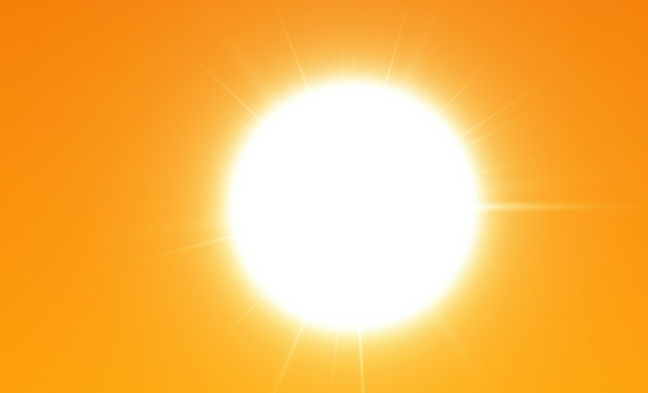
Figure 2: Hot source of light: the sun
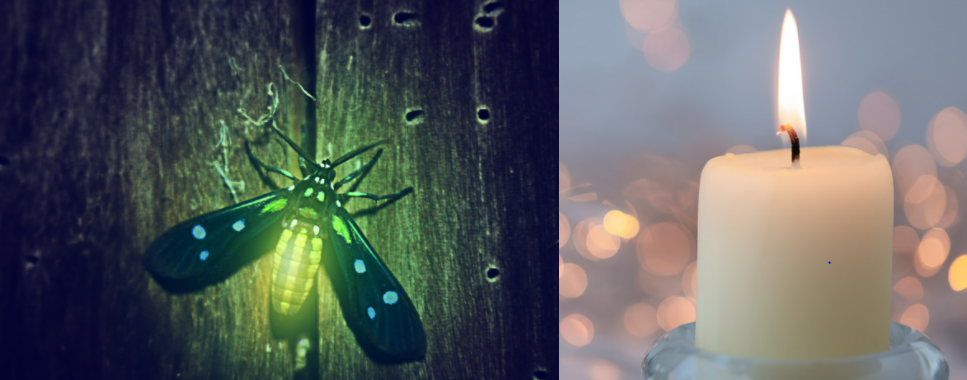
Figure 1: Sources of light: a) Cold source of light: Firefly(natural source; b) Candle(man-made source)
Bioluminescence: A natural phenomenon of emitting light by the objects. In bioluminescence, the objects covert chemical energy into light energy. Some of the examples are phytoplankton, fireflies, jellyfish and algae, etc.
Luminous objects: The objects that have their own light. For example, the sun, stars and torch, etc.
Non-luminous objects: The objects that do not produce their own light. For example tables, chairs and books, etc.
Objects that do not produce their own light but are visible when reflect light falling on them are called Non-Luminous Objects. Example - Table, planets. Non-luminous objects can be classified as:

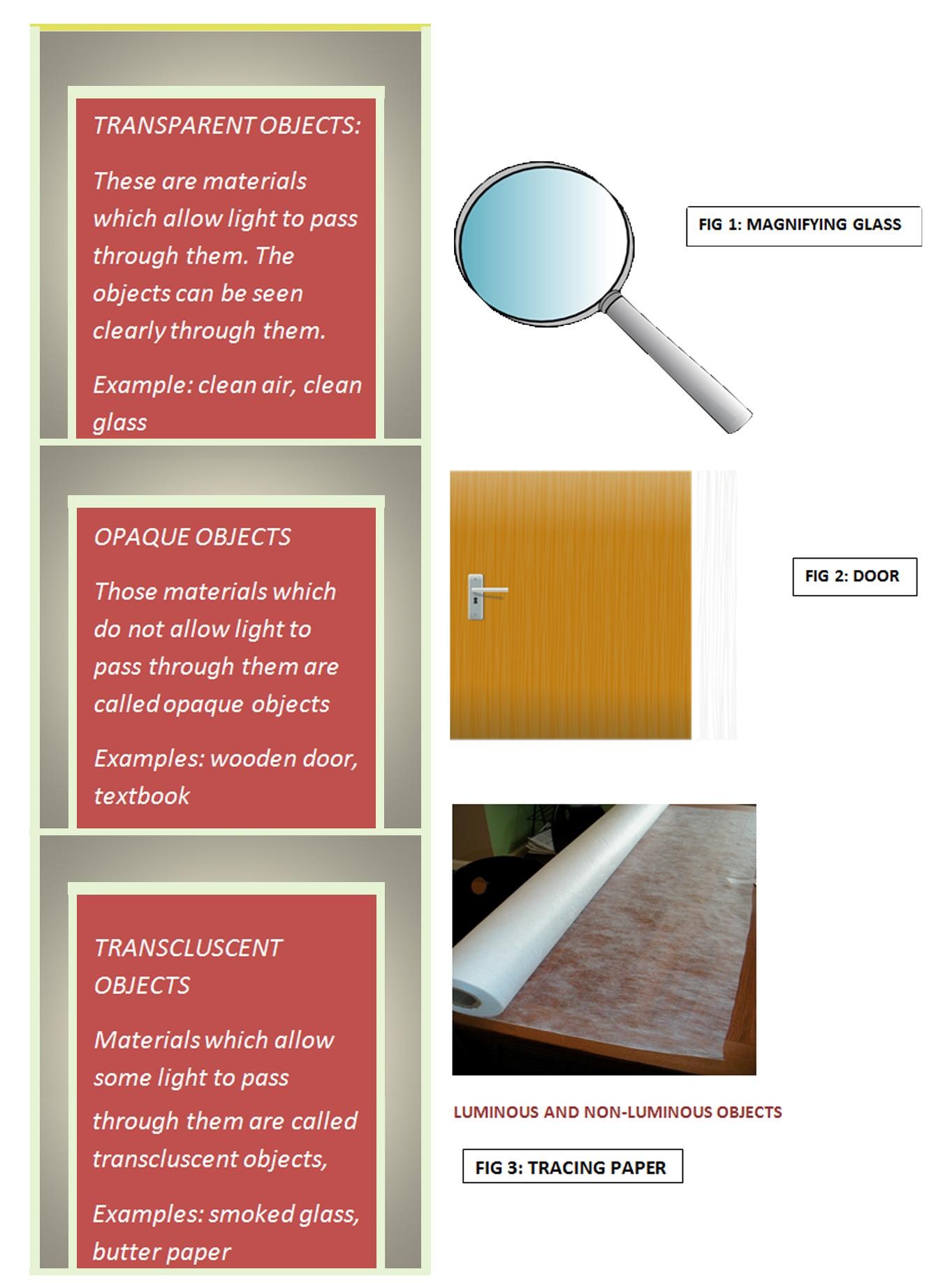
Propagation Of Light
Usually light travels in a straight line. When we want to represent the propagation of light with a diagram, we represent it with the help of rays and beams. Ray A ray is a line with an arrow that shows the direction of propagation of light, and such a diagram is called a ray diagram.
Beam A group of light rays moving in an organized manner is called a beam of light.
The property of light to travel in straight lines explains many interesting phenomena related to light, like formation of shadows by opaque objects and formation of images in a pin-hole camera.

What exactly are shadows?
- Books Name
- Class 6 Science Book
- Publication
- PathSet Publications
- Course
- CBSE Class 6
- Subject
- Science
What exactly are shadows?
Shadows are dark regions formed when an opaque object blocks the path of light. This formation is possible only because light only travels in a straight line.
Shadows
An opaque object blocks the light falling on it. This creates an area of darkness on the side of the object away from the source of light. A translucent object also creates a faint area of darkness. An area of darkness formed by an opaque object obstructing light is called a shadow. The following three things are required for a shadow to form (Fig. 13.4):
- a source of light
- an opaque object
- a screen or face behind the object.
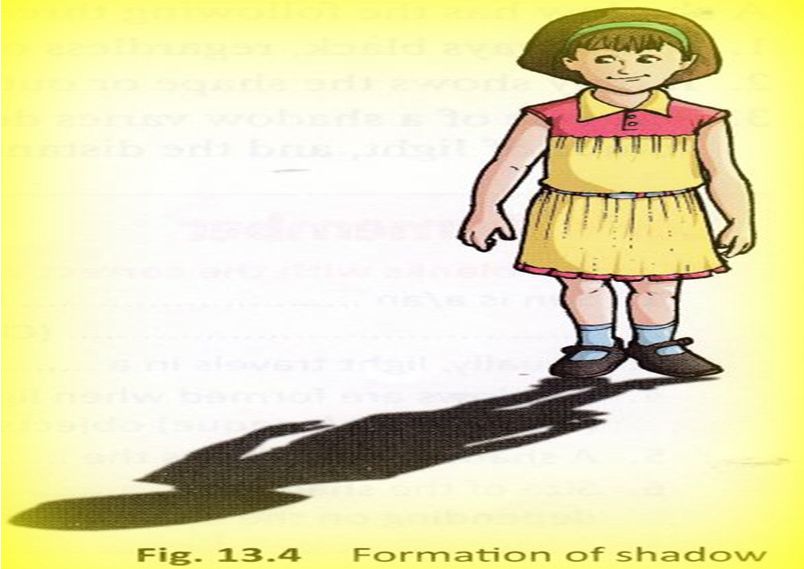
Formation of shadows
A shadow will not form if any of these is absent. This explains why we cannot see a shadow in the dark. It is only when light rays are obstructed by an opaque object that we get a shadow of the object. When an opaque object is placed in path of light, a dark portion is formed on the opposite side of object on the screen. This dark portion is shadow.
(1) The size of shadow depends on the distance of source of light and on the angle at which the light rays fall on the object.
(2) If the source of light is closer to the object, a larger shadow is formed than when the source of light is far from the object.
(3) The shadow can be seen only on a screen. The ground, walls of the rooms, a building, or other such surfaces act as a screen for the shadows you observe in everyday life
(4) Shadows sometimes gives lot of information about the object.
(5) Shadows are in black in colour and this is not changed by the colour of the opaque objects. So a red and yellow rose will have same black shadows.
Nature of a Shadow
The shadow is categorized into two parts based on the brightness of the dark patches:-
i. Umbra: It is the darkest part of the shadow present in the middle of it, which forms due to the absence of light.
ii. Penumbra: It is the faintest part of the shadow present at the corners of it. It is formed when the light is not completely blocked (Figure 7).
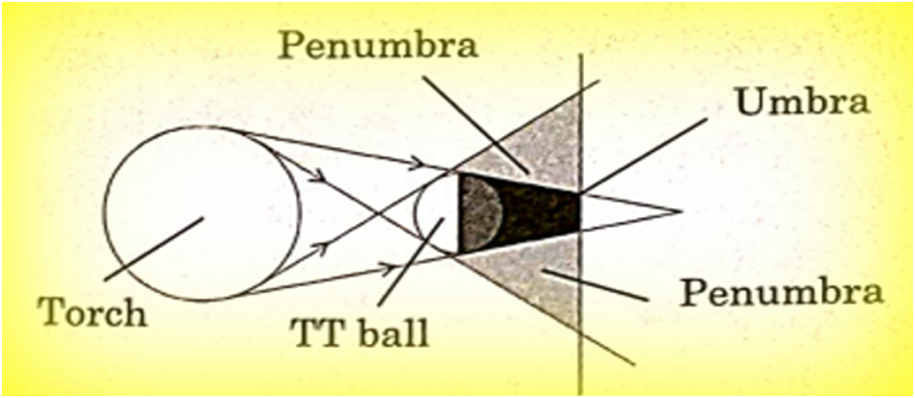
Figure 7: Umbra and Penumbra
Characteristics of a Shadow
- An opaque screen is required to form a shadow. If there is no screen, then no shadow will form.
- The colour of the shadow is always black.
- A shadow casts the shape of the opaque object only.
The size of the shadow varies according to the presence of light coming from the different angles:-
- If the distance between the source of light and an opaque object is decreased, then the size of the shadow forms large dark patches.
- If the distance between the source of light and an opaque object is increased, then the shadow is small.
- If the distance between the object and the screen is decreased, then the shadow is small.
- If the distance between the object and the screen is increased, then the shadow is large.
A pinhole camera
- Books Name
- Class 6 Science Book
- Publication
- PathSet Publications
- Course
- CBSE Class 6
- Subject
- Science
A Pinhole Camera
How to make a Pinhole Camera?
Step 1: Take two cardboard boxes one larger than the other such that one box slides into the other without any gap.
Step 2: Cut out open one side of each box. On the opposite side of the larger box cut a small hole in the center.
Step 3: On the opposite side of the smaller box cut a square of about 5 cm and cover this open area with a tracing paper.
Step 4: Slide the smaller box inside the larger one such that the side with the tracing paper is on the inside.
Step 5: Cover the camera and your head with a black cloth and then get ready to observe the distant objects.
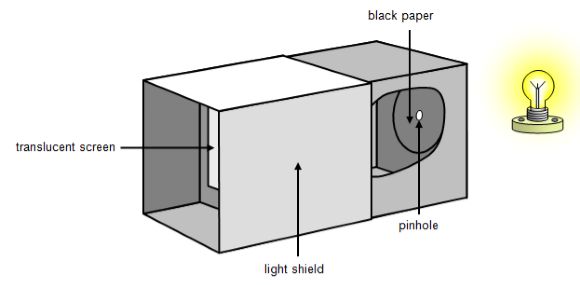
Fig: A Pinhole Camera
It is a simple camera with a small aperture and forms an inverted image of the object.
A Pin-Hole Camera
How to prepare it
(1) Take two boxes so that one can slide into another with no gap in between them. Cut open one side of each box.
(2) On the opposite face of the larger box, make a small hole in the middle.
(3) In the smaller box, cut out from the middle a square with a side of about 5 to 6 cm.
(4) Cover this open square in the box with tracing paper (translucent screen).
(5) Slide the smaller box inside the larger one with the hole, in such a way that the side with the tracing paper is inside
Now it is ready to use
How to use it
(1) Hold the pin hole camera look through the open face of the smaller box. You should use a piece of black cloth to cover your head and the pinhole camera.
(2) Now focus on the object you want to capture in the camera. Make sure that the objects you wish to look at through your pinhole camera are in bright sun shine.
(3) Move the smaller box forward or backward till you get a picture on the tracing paper pasted at the other end
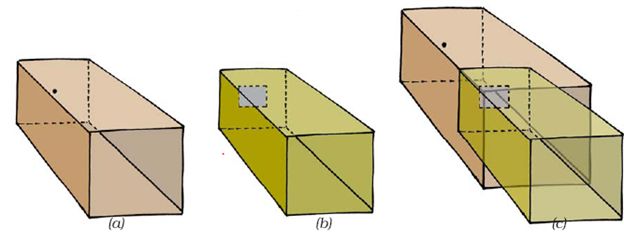
How the Images looks like pin-hole camera?
Upside down (inverted) images are formed. Image in a pin hole camera is real , inverted and smaller in size.

A pinhole camera that is used to capture the images of the sun is called Solography.
Natural Pin-hole Camera
When we pass under a tree covered with large number of leaves, we notice that small patches of sun light under it. These circular images are, in fact, pin hole images of the Sun. The gaps between the leaves, act as the pin holes. These gaps are all kinds of irregular shapes, but, we can see circular images of the Sun. This is called Natural Pin-Hole Camera
Rectilinear Propagation of Light
- The property by which the light travels in a straight line is called rectilinear propagation of light.
- The path travelled by a light in a straight line is identified with the help of a ray of light. The arrow head shows the direction of light(Figure 5 a).
- A narrow group of light rays called a beam(Figure 5 b).
- When beam of light moving away from each other is called divergent rays(Figure 5 c).
- When beam of light moving towards each other and meet at a common point then it is called convergent rays(Figure 5 d).
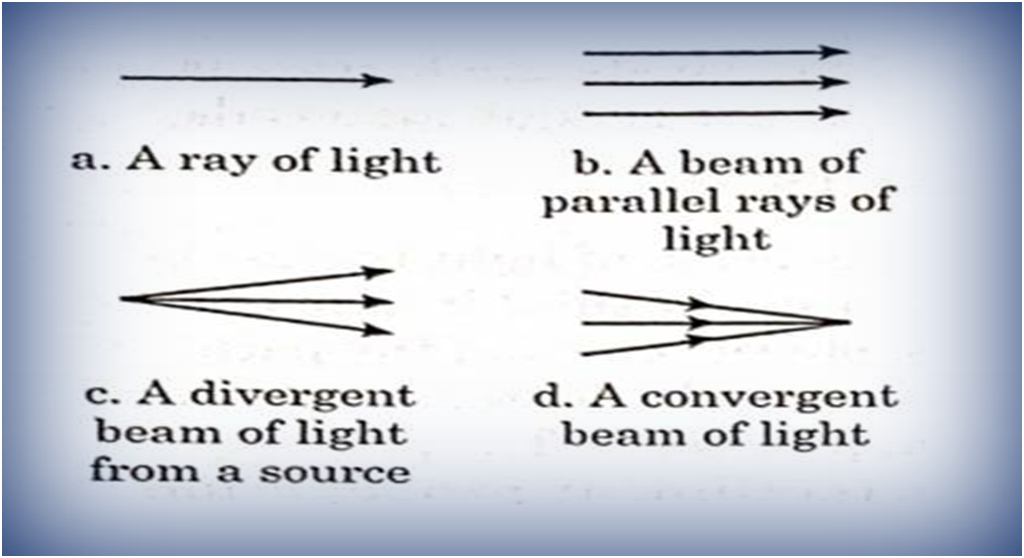
Figure 5: Property of light.
Producing a Beam of Light
- We produce a beam of light by using a light box.
- The light box is composed of a cardboard box with a tiny hole on one of its faces and an electric bulb.
- When an electric bulb glows, the light comes out of the hole producing a beam of light.
Mirrors and reflections
- Books Name
- Class 6 Science Book
- Publication
- PathSet Publications
- Course
- CBSE Class 6
- Subject
- Science
Mirrors and Reflections
Mirror
We all have seen the plane mirror. It is very commonly used in our life. We used that in the car, dressing room etc. Plane mirror are formed by layering molten aluminum or silver onto the back of a sheet of glass inside a vacuum
Reflection of Light
We see our face in the Mirror. This is possible through the phenomenon Reflection of light. Basically Light rays reflected from parts of our body fall on mirror and are reflected back. When these reflected rays reach our eyes (reflected on our retina), we can see the image in the mirror.
So reflection of light is changing the direction of the light.
Image formation by Plane Mirror
- A plane mirror reflects the light that falls on it.
- The beam of light that falls on the mirror is called incident ray, while the light that reflects called the reflected ray.
- The angle of incident ray equals to the angle of the reflected ray.
- The incident ray, reflected ray and normal ray lies at the common point of the mirror (Figure 11).
- A plane mirror has a property of lateral inversion in which the image formed in the mirror has an opposite side. For example, when you see your image in the mirror your right hand becomes left and your left hand becomes right.
- The image formed is erect, same size and laterally inverted. It retains the same colour as the object.
All of us are used to seeing a mirror every day. The image that we see in a mirror is called Reflection. The mirror deflects the direction of the light that falls upon it.
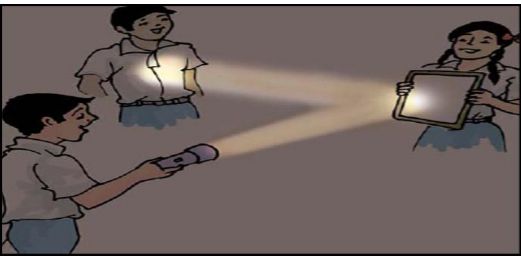
Fig: A Mirror Changing the direction of light as it falls on it
Reflection Surfaces
We say light is reflected when it bounces off a surface. Reflection of light helps us to see most of the things around us.
Reflection of light by a surface depends on the nature of the surface. A rough and bumpy surface (also called an irregular surface) reflects a parallel beam of light incident upon it in different directions (Fig. 13.5). A good example of a rough surface is bark of a tree and blanket. This kind of reflection is called diffused reflection.
A smooth surface (a highly polished surface) reflects a parallel beam of light incident upon it in one direction. (Fig. 13.6). A good example of a smooth surface is a mirror. When you stand in
front of a mirror, you can see yourself in the mirror. This is called your image.
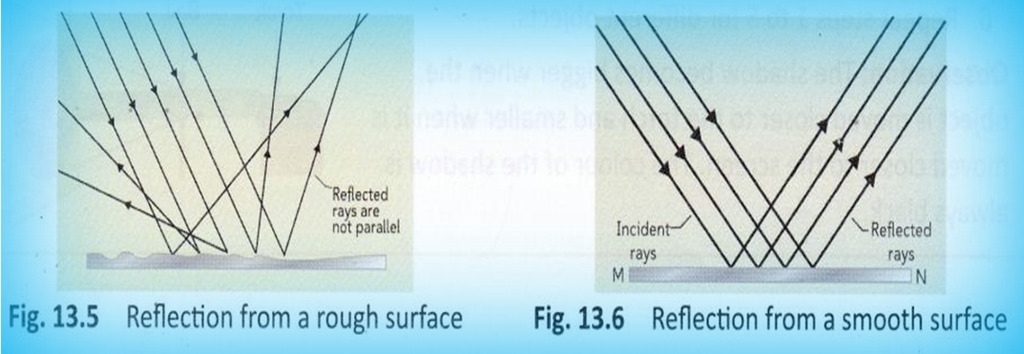
A very interesting phenomenon occurs when an object forms an image by reflection. This is something all of us must have noticed while seeing ourselves in the mirror. When we lift our right hand, the image in the mirror appears to lift its left hand. This seeming left-right reversal is called Lateral inversion.
Lateral inversion: Right side of the object appears as left side in the image formed by a plane mirror. For example, if we show our right hand, image in the mirror will show as left hand.
In a mirror, if you see another person, surely the other person can also see you in that mirror.
An image is different from a shadow. Some of the differences between an image and a shadow are given in Table 13.1

SUMMARY
Source of light: An object that gives out light (luminous object) is called a source of light.
Transparent material: A material that transmits all the light is called a transparent material.
Translucent material: A material that transmits some amount of light is called a translucent material.
Opaque material: A material that completely blocks the light is called an opaque material.
Shadow: An area of darkness formed by an opaque object obstructing light is called a shadow.
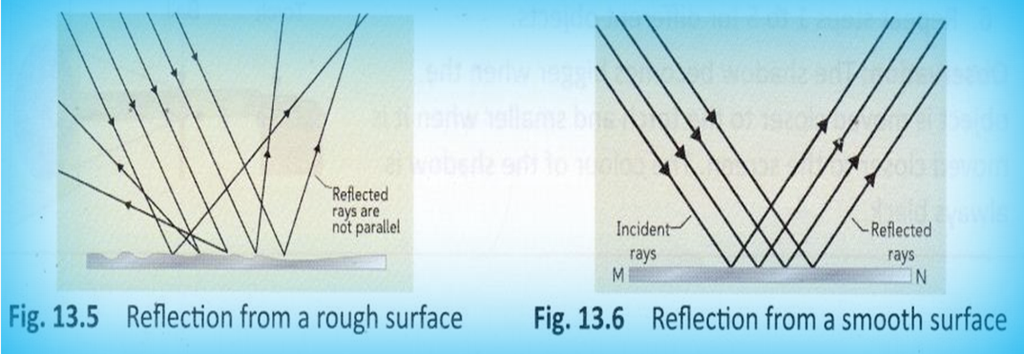

 Param Publication
Param Publication
 PathSet Publications
PathSet Publications
